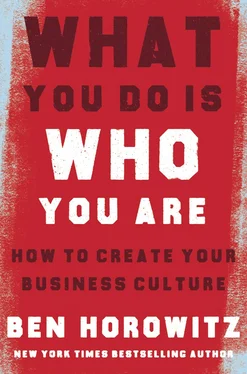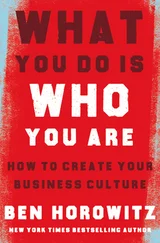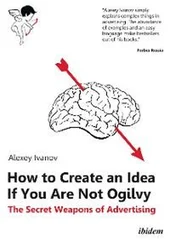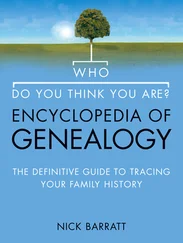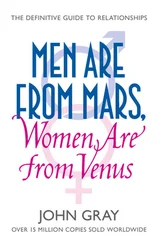Culture is not like a mission statement; you can’t just set it up and have it last forever. There’s a saying in the military that if you see something below standard and do nothing, then you’ve set a new standard. This is also true of culture—if you see something off-culture and ignore it, you’ve created a new culture. Meanwhile, as business conditions shift and your strategy evolves, you have to keep changing your culture accordingly. The target is always moving.
CULTURE IS THE STRONG FORCE
In business, if you have a strong culture but a product nobody wants, you fail. So culture might appear to be weaker than product. But if you look more deeply, over time, culture can overcome the seemingly invincible structural barriers of an era and transform the behavior of entire industries and social systems. From this broader perspective, culture is the strong force in the universe.
In the 1970s, a bunch of poor kids from the Bronx created a new art form, hip-hop. In a single generation they overcame poverty, racism, and massive opposition from the music industry to build the world’s most popular musical genre. They changed global culture by inventing a culture premised on candor and a hustler’s mentality.
The hustler’s mentality could be seen in how hip-hop DJs sourced their basic building block: breakbeats. Breakbeats were the part of the song that everyone got excited about on the dance floor—the beat-heavy breakdown sections that featured drums and bass, or just drums. The freshest breakbeats, the ones people hadn’t heard before, were often found on obscure records. Because these records were obscure, the record companies wouldn’t restock them if they suddenly sold out, which created a supply-chain problem. Hip-hop’s entrepreneurial culture worked right around it. Ralph McDaniels, who put the first rap videos on television and who coined the term “shout-out,” told me:
A guy named Lenny Roberts supplied these records to the stores and he knew precisely what was going to sell, because he was from the Bronx and that’s where it was all breaking. He marketed these breakbeats by giving them to Afrika Bambaataa or Grandmaster Flash, and when Flash played it every DJ would go, “Oh, I’ve got to have that record,” and the records would instantly sell out. So Lenny pressed his own records with just the breakbeats: the Breakbeats Volume One, Breakbeats Volume Two, etc. He didn’t have the rights, of course, but nobody was paying any attention.
People often ask me why I preface much of what I write with quotes from hip-hop. In part it’s a hangover from my failed career as a rapper—true story. But mostly it’s because the majority of my ideas about entrepreneurship, business, and culture occur to me while I’m listening to hip-hop, so it’s my way of giving credit where credit is due. I always felt that early hip-hop songs like Eric B. & Rakim’s “Follow the Leader” or Run-DMC’s “King of Rock” were about what I was doing as an entrepreneur. They are the culture in which I work.
While the hustling part of hip-hop culture made the business go, it was the honesty that drew the fans. The great rapper Nas told me that as a kid:
The rawness was what I gravitated towards. The world was supposed to be this picture-perfect place, the Brady Bunch. We’re all trying to be the Brady Bunch, but really we’re the Little Rascals. Rap explained what’s really going on—the crimes, the poverty, the corrupt police. Rap cleansed itself of pimp-sounding music or gospel-sounding music or a funky sound or a hippie sound. It extracted all that other stuff out of it and ripped itself raw until it was simply about honesty.
A continent away from the Bronx, a group of engineers in California established a set of cultural innovations that would end up changing how almost every business operates. In the 1960s, Bob Noyce, the coinventor of the integrated circuit, or microchip, ran Fairchild Semiconductor, a unit of Fairchild Camera and Instrument Corporation.
Fairchild Camera, based in New York City, did business the east coast way, which had become the way big businesses across the country conducted themselves. Fairchild’s owner, Sherman Fairchild, lived in a glass-and-marble town house in Manhattan. His top executives got cars and drivers and reserved parking places. As Tom Wolfe observed in his 1983 Esquire story “The Tinkerings of Robert Noyce,” “Corporations in the East adopted a feudal approach to organization, without even being aware of it. There were kings and lords, and there were vassals, soldiers, yeomen, and serfs.”
Bob Noyce didn’t believe any of that made sense when it was his individual engineers—the yeomen—who were inventing products and driving the business. So Fairchild Semiconductor did things differently. Everyone was expected at work by 8 a.m., and whoever got in first got the best parking space. The company’s building in San Jose was a warehouse filled with cubicles, and nobody wore a suit.
Noyce didn’t hire professional managers. He said, “Coaching, and not direction, is the first quality of leadership now. Get the barriers out of the way to let people do the things they do well.” This created a new culture, a culture of empowerment: everyone was in charge and Noyce was there to help. If a researcher had an idea, he could pursue it for a year before anyone would start inquiring about results.
Employees who got a taste of Noyce’s culture of independence split off to start their own companies, including Raytheon Semiconductor, Signetics, General Microelectronics, Intersil, Advanced Micro Devices (AMD), and Qualidyne. Without exactly meaning to, Noyce had created the culture of Silicon Valley.
In 1968, Noyce himself split off to start a new company, resigning from Fairchild Semiconductor after being passed over for CEO of Fairchild Camera. He and his colleague Gordon Moore—the coiner of Moore’s law, which holds that microchip capacity doubles every eighteen months while its price falls in half—and a young physicist named Andy Grove founded Intel to tackle the nascent field of data storage.
At Intel, Noyce took his egalitarian ideas to a new level. Everyone worked in one big room with partitions separating them; Noyce himself sat at a secondhand metal desk. Lunch was deli sandwiches and soda. There was no layer of vice presidents; Noyce and Moore oversaw business segments run by middle managers who had enormous decision-making power. In meetings, the leader set the agenda, but everyone else was equal.
And, crucially, Noyce gave the engineers and most of the office workers substantial stock options. He believed that in a business driven by research and products, the engineers would behave more like owners if they actually owned the company.
Wolfe observedthat “At Intel everyone—Noyce included—was expected to attend sessions on ‘the Intel Culture.’” The culture was drilled into new employees by Andy Grove (who would go on to become the company’s CEO and a famous cultural innovator). Grove would ask, “How would you sum up the Intel approach?” Someone might answer, “At Intel you don’t wait for someone else to do it. You take the ball yourself and run with it.” Grove would reply, “Wrong. At Intel you take the ball yourself and you let the air out and you fold the ball up and put it in your pocket. Then you take another ball and run with it and when you’ve crossed the goal you take the second ball out of your pocket and reinflate it and score twelve points instead of six.”
This atmosphere allowed ideas to prosper; if Silicon Valley is about anything, it’s about the primacy of the idea. Breakthrough ideas have traditionally been difficult to manage for two reasons: 1) innovative ideas fail far more than they succeed, and 2) innovative ideas are always controversial before they succeed. If everyone could instantly understand them, they wouldn’t be innovative.
Читать дальше
